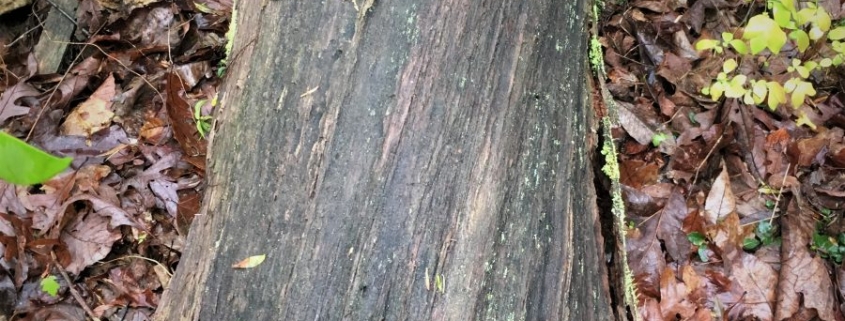Special Features at DeSoto State Park in Northeastern Alabama
See my earlier Posts describing the Magic of Water’s Thunder at DeSoto State Park: https://stevejonesgbh.com/2019/05/15/the-magic-of-waters-thunder-at-desoto-state-park/ and DeSoto’s Magical Sandstone Glades: https://stevejonesgbh.com/2019/06/05/sandstone-glades-at-desoto-state-park/
I stayed at the Park April 18-20; rain fell in torrents the night of the 18th, and light rain and drizzle persisted until I departed mid-day on the 20th. Although I snapped this photo on a prior visit, it seemed fitting for this Post!
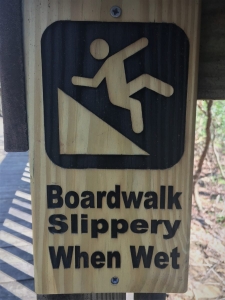
Stone Formations
DeSoto State Park sits atop Lookout Mountain. The “mountain” is a flat-topped 50-mile linear erosional remnant (up to ten miles wide) of the broader Cumberland Plateau that lifted during the Appalachian orogeny some 225-260 million years ago. Lookout Mountain, Sand Mountain, and Blount Mountain are three of the ridges that together with erosional valleys constitute the eight units of the Cumberland Plateau. The Plateau-topping sandstone lies at the surface of DeSoto’s sandstone glades (below left). Sandstone likewise provides the shelves, cliffs, and ledges over which DeSoto’s multiple falls tumble (below right).
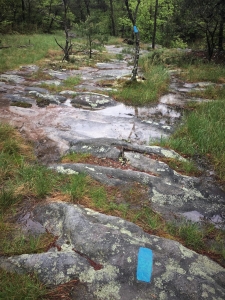

This one photograph is emblematic of the marriage of rock and forest at DeSoto.
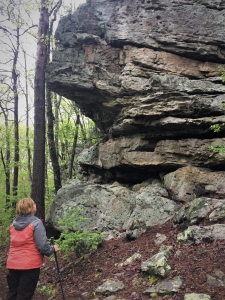
Powerful forces shape and sculpt Earth’s features. Stand at any number of Cumberland Plateau scenic overlooks and imagine the peneplain that stretched to the horizon eons ago, level with your current perch above the broad valley. All that was there has long ago entered the Tennessee River–to the Ohio–and on to the the mighty Mississippi into the Gulf of Mexico. And still, the process continues inexorably. Lichens and algae on rock faces exact chemical and physical tolls. The foot-wide fissure separating the two large sandstone blocks (below left) certainly felt the unfathomable pressure of freezing seepage, as well as expansion and contraction from diurnal and annual temperature fluctuations from 0-to-90-degrees F. Tree roots also join the assault. The nearly prostrate sourwood (Oxydendrum aboreum; lower right) and the many other tree, shrub, and herbaceous species anchoring nearby pull their share of the weathering load. There will come a day when these rocks, too, will feel the tropical warmth of Gulf waters. After all, time means nothing to a grain of sand.
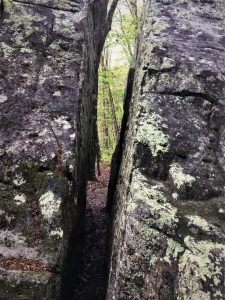
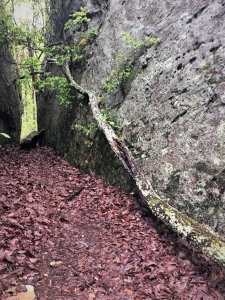
Allow me a postscript on the sourwood, one of my favorite southern trees. I’ve noted in previous Posts that sourwood pays scant attention to both the laws of gravity (it disdains growing vertically) and it refuses to be a slave to sunlight. Most trees species are either positively phototropic (grow toward the sun) or negatively geotropic (grow opposite gravity’s pull). Sourwood plays by its own rules. The tree above, shall we say, is true to form. It did not fall to this position — it grew that way! I admire its spirit of independence and its rebel demeanor. It seems to literally chart its own path and destiny.
I puzzled over this two-foot circular hole about half-way up the side of a 20-foot high rock face. Man made? An accident of Nature? Some explainable physical phenomenon? Worth a photo and a bushel of curiosity. I may never know. Perhaps the answer is clear to you.
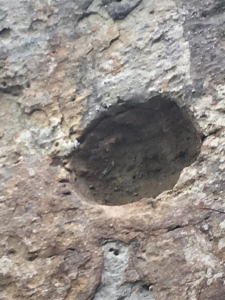
I leave the mystery for now to Park Naturalist Brittney Hughes who led me through a full soggy day at DeSoto.
Park Oddities
Nature’s portfolio is rich with wonder as well as special features. I have yet to venture into Nature anywhere I’ve trod, to include on several continents, and not found additional oddities to add to my photo collection and memory. I like this yellow poplar (Liriodendron tulipifera) kissing the tilted, lichen-encrusted sandstone block. Animate and inanimate reside proximal and interactively.
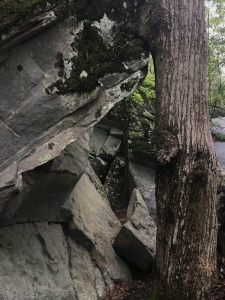
While I admitted a special fondness for sourwood, Brittany feels deep reverence for black birch (Betula nigra). This species, whether in upstate New York or here in the southern Appalachians, is adept at dropping seeds that seem to germinate and find purchase in the most unusual places. These two found anchorage on the side of a mossy rock and dropped roots along the rock to find true soil and suitable substrate on the forest floor. They are resilient and opportunistic, an admirable character for true forest entrepreneurs… or, for that matter, for human business entrepreneurs.
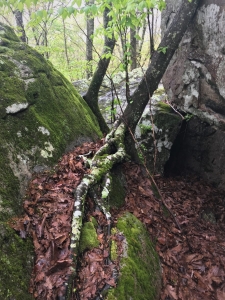
Clouds, drizzle, and mystery enveloped us. I glanced up to find an Ewok village. As a reminder to those of you who are Star Wars enthusiasts, “Ewoks were a diminutive species of furry bipeds native to the forest moon of Endor. They were most notable for helping the Rebel Alliance defeat the forces of
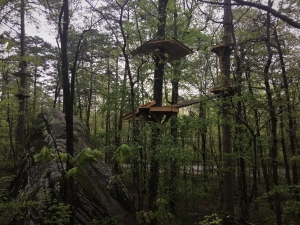
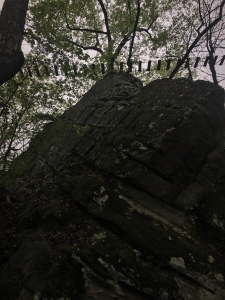
Appropriately, the Park traces the Orange Trail with, you guessed it, orange paint. Perhaps the painting crew passed this way during the Halloween season, showing creativity and demonstrating mirth on a trail-side Virginia pine (Pinus virginiana) canker face. Not limiting themselves to orange, the crew even added a green stem stump (below right)! Such a delight on a dark and sodden hike, warming my heart and brightening the day.
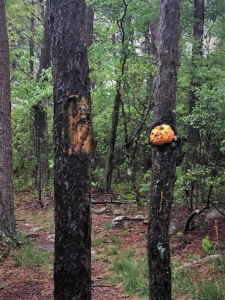
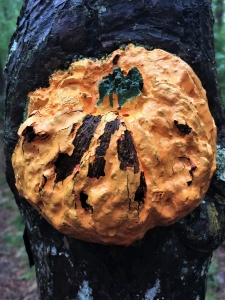
And no fungal agents at work on this tree near the Lodge!
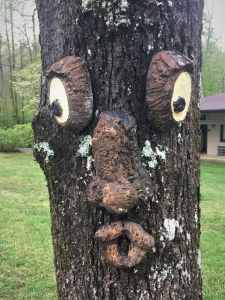
Puzzling Spiral Grain
Over my entire forestry career, I have noticed that trees grow with spiral grain. And I’ve puzzled over the cause and expression. I am not alone in such pondering. From the online Gymnosperm Database: “Spiral grain is the helical form taken by xylem tissues in their growth along a tree trunk or limb. Spiral grain is often conspicuous in snags that have lost their bark, as shown in the photos on this page, and people love to speculate about it. You will hear, for instance, that it is caused by the Coriolis force or that trees always spiral one direction in the northern hemisphere and the other direction in the southern hemisphere.
The phenomenon and causes of spiral grain have received considerable study, perhaps because it affects the commercial value of wood. Kubler (1991) provides an extensive (though somewhat dated) bibliography. He noted that spirals “are commonly observed in both directions (left-handed and right-handed), and that the direction of spiral can reverse several times during a tree’s life. I have seen that attested in a decaying alpine log of Engelmann spruce.” Kubler also noted that trees can spiral for many different reasons.
Don’t look for me soon to Post an answer or solve the mystery. The spiral grain I photographed in de-barked dead Virginia pine (a sample of four below expressed as right-handed.
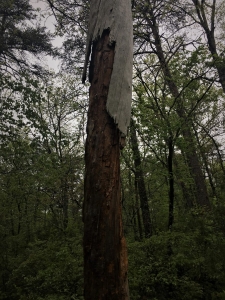
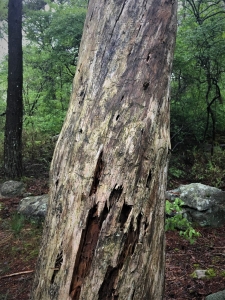
I’ll accept the online wisdom, which continued, “Spiraling can also occur (and this is probably more common) in response to stress: there is a helical stress imposed on any tree that is exposed to prevailing wind and has an asymmetrical crown, which is common in trees growing on exposed sites. Gravity can also impose a helical stress on a leaning tree. It has also been noted that spiral grain may make the tree stronger and better able to withstand stresses caused by wind, particularly if the direction of the spiral is periodically reversed. This concept was developed in some detail by Skatter and Kucera (1998) who studied wind effects on trees with asymmetrical crowns and showed that ‘spiral grain is an optimized growth feature when the trees are exposed to combined bending and torsion.’ They also assert that most conifers spiral at the same rate (called the grain angle) and show a change from left-handed to right-handed spiraling as they age.”
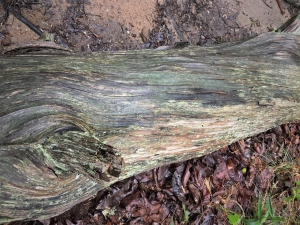
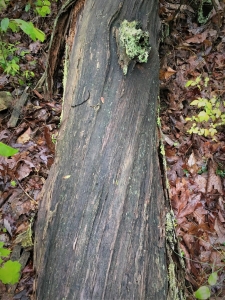
Again, if experts who have studied this phenomenon are able only to speculate, I will not attempt to advance the frontiers of knowledge and understanding. Instead, I may simply continue to ask others for an explanation. I may generate some wild flights of fancy from those who are never at a loss for words and likewise seldom pass up an opportunity to express their perspicacity and infinite wisdom!
DeSoto State Park is a place of special features.
Thoughts and Reflections
I wrote my books Nature Based Leadership (2016), Nature-Inspired Learning and Leading (2017), and Weaned Seals and Snowy Summits: Stories of Passion for Place and Everyday Nature (2019; co-authored with Dr. Jennifer Wilhoit; Submitted to publisher May 31, 2019), as well as another one by me (single author) scheduled for 2020, Natural Elixir: Lifting Your Life through Nature’s Inspiration, to encourage all citizens to recognize and appreciate that every lesson for living, learning, serving, and leading is either written indelibly in or is powerfully inspired by Nature. Both published books are available on Amazon and other online sources.
Here are the three succinct lessons I draw from this Blog Post:
- Nature’s magic manifests in ways often least anticipated — not always in towering trees and cathedral groves.
- Enter the forest with open mind, probing eyes, and a sense of childlike wonder.
- Always seek what lies hidden within… and you will find it.
Inhale and absorb Nature’s elixir. May Nature Inspire and Reward you!
Note: All blog post images created & photographed by Stephen B. Jones unless otherwise noted. Please circulate images with photo credit: “©2019 Steve Jones, Great Blue Heron LLC. All Rights Reserved.”
Another Note: If you came to this post via a Facebook posting or by an another route, please sign up now (no cost… no obligation) to receive my Blog Post email alerts: https://stevejonesgbh.com/contact/
And a Third: I am available for Nature-Inspired Speaking, Writing, and Consulting — contact me at steve.jones.0524@gmail.com
Reminder of my Personal and Professional Purpose, Passion, and Cause
If only more of us viewed our precious environment through the filters I employ. If only my mission and vision could be multiplied untold orders of magnitude:
Mission: Employ writing and speaking to educate, inspire, and enable readers and listeners to understand, appreciate, and enjoy Nature… and accept and practice Earth Stewardship.
Vision:
- People of all ages will pay greater attention to and engage more regularly with Nature… and will accept and practice informed and responsible Earth Stewardship.
- They will see their relationship to our natural world with new eyes… and will understand more clearly their Earth home.
Tagline/Motto: Steve (Great Blue Heron) encourages and seeks a better tomorrow through Nature-Inspired Living!
Alabama State Parks Foundation
I’ll remind you that I serve on the Foundation Board, in part because of my love of Nature and in recognition for my writing many prior Posts about visiting and experiencing the Parks. I urge you to take a look at the Foundation website and consider ways you might help steward these magical places: https://asparksfoundation.org/ Perhaps you might think about supporting the Parks System education and interpretation imperative, including initiatives related to exploring and revealing what lies hidden in plain sight.

